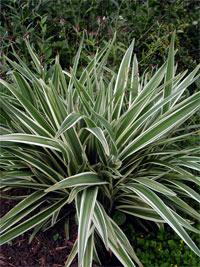
Plant of the Month: Dianella tasmanica
Variegata
Flax Lily, Dianella tasmanica
AT A GLANCE
Latin name: Dianella tasmanica ‘variegata’
Common name: flax lily
Origin: New Zealand
Plant type: perennial
Flowers: panicles of pure blue 3/4-in. stars
Foliage: 2-in. wide, grass-like, upright
Mature height: 2 ft.
Hardiness: Zone 7 south
Soil: well drained
Exposure: full sun to light afternoon shade
Water usage: low
Sources: mail order/retail
Anyone who knows me, or has read much of my writing, is familiar with my predilection for foliage plants. I’m not a subtle person and neither is my garden. In my constant search for foliage interest in the garden, I occasionally find a true gem, and a genus that is truly beginning to shine for us Texas gardeners is Dianella.
This grass look-a-like plant is really a member of the lily family. Two-inch-wide leaf blades of bright, shiny green foliage, banded in pure white, stand out in the landscape from a long distance. Surprisingly, it does as well in full sun as it does in partial shade. Resembling a giant variegated liriope, this plant puts out large panicles of true blue flowers. Although each flower is only a 1/2-inch across, the multitude of them comes across as a light blue cloud floating around the plant. If you are lucky, the flowers will mature into grape-sized metallic-blue berries that look as if they were carved from metal.
I love this plant for foliage interest in container combinations and as spotted accents in shade. You will now see it at the Dallas Arboretum en masse in light shade areas. The foliage will die back to the ground at temperatures around the mid-20s, but springs back quickly in spring. Plants are exceptionally drought tolerant once established, but will also survive our summer monsoons and not rot.
Recently I’ve discovered a new solid-green variety, Dianella ‘Becca’, which has a smaller and more compact habit, along with bluish-green foliage. This particular variety produces huge masses of flowers in large clusters.
